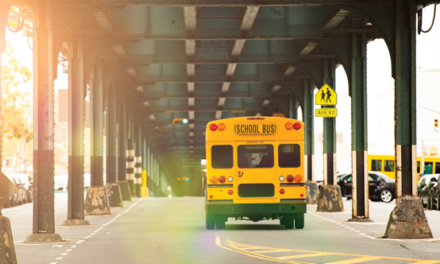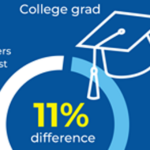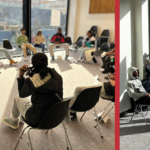I remember two things about Mrs. Penny’s 8th-grade language arts class. First, every Monday morning, she set the tone for the week by playing the song “Monday, Monday” by one of her favorite bands, The Mamas & The Papas. Second, I recall writing lots of practice essays, far more than I cared to. These memories stand out, I think, because they represent the totality of my experience as a Black kid in a Black school with teachers — white and Black — who wrestled with ensuring their class met the state standards, while also trying to bring creativity to their classrooms. I can’t help but wonder what Mrs. Penny would have done if freed from the restrictions of testing standards, or if those standards were broad enough to open new possibilities. So, let’s take a moment and explore what a reimagined version of accountability can look like.
Brief history of testing
Testing, as a national practice, dates to a time when arguably the most important race for America was the race to the moon. After the United States entered a Cold War competition with the Soviet Union to reach the white cratered satellite in the sky, the Reagan administration authored A Nation at Risk. The 1983 report pushed for more rigorous instruction, particularly in math and science. It identified expansive testing as a primary tool to ensure that rigor. Our ideas about how students, teachers, and entire schools were doing became linked to testing performance.
Every major education policy reform of the modern era has been about tightening or loosening that link. The No Child Left Behind Act of 2001 codified state testing accountability with aggressive federal oversight. The Every Student Succeeds Act of 2015 loosened federal oversight to (re)empower state education agencies. Note that both reforms are reauthorizations of the Elementary and Secondary Education Act (ESEA) of 1965, which was a part of a larger anti-poverty program. The ESEA hardly mentions testing. Essentially, we went from investing money in students to doing so with heavy strings attached. Those strings have combined to become a rope.
On its own, testing is not the problem. The issue is that policy makers conflate testing and assessment. Assessment is an integral part of any educational process, academic or otherwise. Whether we’re learning how to swim, drive a car, or grow vegetables, we need to make sure learning is taking place. Testing is useful as one of multiple assessment tools. Testing is harmful as the primary, let alone the only, assessment tool. Testing is particularly harmful when outcomes determine a kid’s future, a teacher’s livelihood, or an entire school’s reputation. This is how the rope can strangle.
Testing today
Now is a critical moment for test-based accountability. Recently released National Assessment of Educational Progress (NAEP) scores revealed the sharpest decline in student achievement in two decades. If you’ve spent any time over the past year talking with teachers and administrators, you knew that the decline was coming. COVID-19 disrupted everything. Critiques of school closures and remote instruction point to hours and hours of lost in-person instruction.
On its own, testing is not the problem. The issue is that policy makers conflate testing and assessment.
However, if you visited schools during the height of the pandemic, as I did, you know that even in-person instruction offered an extremely limited learning environment. It was chaos. Students and teachers were missing days because of COVID scares and actual COVID cases. Staff shortages increased. While operational challenges mounted, kids and teachers were dealing with the trauma of seeing loved ones go to hospitals and never return. This is my own assessment of a situation that the test scores never captured.
Meanwhile, as NAEP results sound national alarm bells, the policy conversation around test-based accountability seems as quiet as it’s been in decades. Heading into congressional elections, education reform is one of the leading national issues. Unfortunately, the major reform being discussed is how to keep critical race theory, anti-racism, and queer perspectives out of social studies curricula. Education policy is caught in the fray of a culture war that seems indifferent to the true needs of students, particularly our most vulnerable. How do we know this? The angry parent groups and school board candidates emerging out of conservative networks seem to care very little about whether our kids are learning math.
New possibilities
Sometimes blessings wear disguises. The current moment of distraction and destruction is the perfect time to innovate. We need meaningful accountability reform. Let’s move away from using tests as instruments to hold teachers and schools accountable for student learning in narrow subject areas. Instead, consider accountability as a way to spur an education system to be accountable to the best version of our students. This means assessing outcomes that policy makers too easily overlook. These outcomes include whether kids are getting to and from school safely, if schools are fostering opportunities for student creativity, and how well students can work with others to solve problems. Schools could empower students and parents to collectively reimagine what their community should look like and establish that as the baseline for accountability. When should teachers and schools be deemed successful? When communities thrive.
Redesigning assessment, though, does not mean de-emphasizing the core curricular areas. We can value math, literacy, and science without a punitive testing environment. In fact, we can assess development in those areas in ways that align with more practical standards. For instance, few of us know that it means to “read at a 5th-grade level” or “do math at a 3rd-grade level.” But we know the real implications of when a child struggles with reading content critical to personal safety and well-being, such as dietary labels, medicine intake instructions, or pedestrian safety rules. We also know the psychological and emotional costs for a child who can’t read and comprehend fantastic stories with incredible moral lessons and empowering messages. Thus, we should be assessing their ability to communicate effectively and share ideas. We also should evaluate how well they build mechanical or technological creations that could improve our quality of life.
We can value math, literacy, and science without a punitive testing environment.
Assessment innovation is far from new. For well over a decade, policy scholars have been calling for new assessments, emphasizing the need for new measures that better reflect the core principles of education (Kirst, 1990; Darling-Hammond, 1991; Meier, 2003; Ravitch & Stoehr, 2017; Schneider, 2017). Policy makers already have incorporated more nuanced assessments in some places. For instance, New York City Public Schools now administers an alternate assessment for students with “severe cognitive disabilities.” California implemented the Smarter Balanced Assessment, which is a computerized, task-based test designed to tap into student knowledge and ability. Moreover, in higher education, elite colleges and universities are experimenting with admission processes that do not factor in test results. A movement for reimagining assessment is quietly growing.
This reimagining is important because assessment is ultimately about freedom. On the last day of 8th grade, I went to Mrs. Penny’s class to retrieve my report card and say goodbye. With elation, she showed me that I had received the highest possible score on the state writing assessment. I was a good student, but far from stellar, caring a tad bit more about what I wore to school than about school itself. So, it was understandable that Mrs. Penny seemed surprised, but I wasn’t. I did not see myself as a gifted writer, but due to the excessive number of practice tests we took, the actual exam prompt was one Mrs. Penny had given us multiple times. It was less a writing assessment than a test of recollection.
It makes me wonder what could have happened if we were truly free. What if Mrs. Penny — a phenomenal teacher — didn’t have to inundate us with practice essay assignments? What if she taught us to explore the multiple uses of language and writing? What if we could have experimented with storytelling, writing about research, or new language-related technologies? What if I could have seen myself and my interests in the fabric of everyday learning? What if the overarching aim of classroom instruction had been to develop tools to uplift our communities that had been exploited, forgotten, and abused? That’s what we should want for the next generation.
That is accountability to the student.
References
Darling-Hammond, L. (1991). The implications of testing policy for quality and equality. Phi Delta Kappan, 73 (3), 220-225.
Kirst, M.W. (1990). Accountability: Implications for state and local policymakers. Information Services, Office of Educational Research and Improvement, U.S. Department of Education.
Meier, D. (2003). In schools we trust: Creating communities of learning in an era of testing and standardization. Beacon Press.
Ravitch, D. & Stoehr, L.A. (2017). The death and life of the great American school system: How testing and choice are undermining education. In Early Learning (pp. 125-128). Routledge.
Schneider, J. (2017). Beyond test scores: A better way to measure school quality. Harvard University Press.
This article appears in the November 2022 issue of Kappan, Vol. 104, No. 3, pp. 61-62.
ABOUT THE AUTHOR

Jonathan E. Collins
Jonathan E. Collins is an assistant professor of political science and education and the associate director of the Columbia University Center for Educational Equity, both at the Teachers College, Columbia University, NY.











